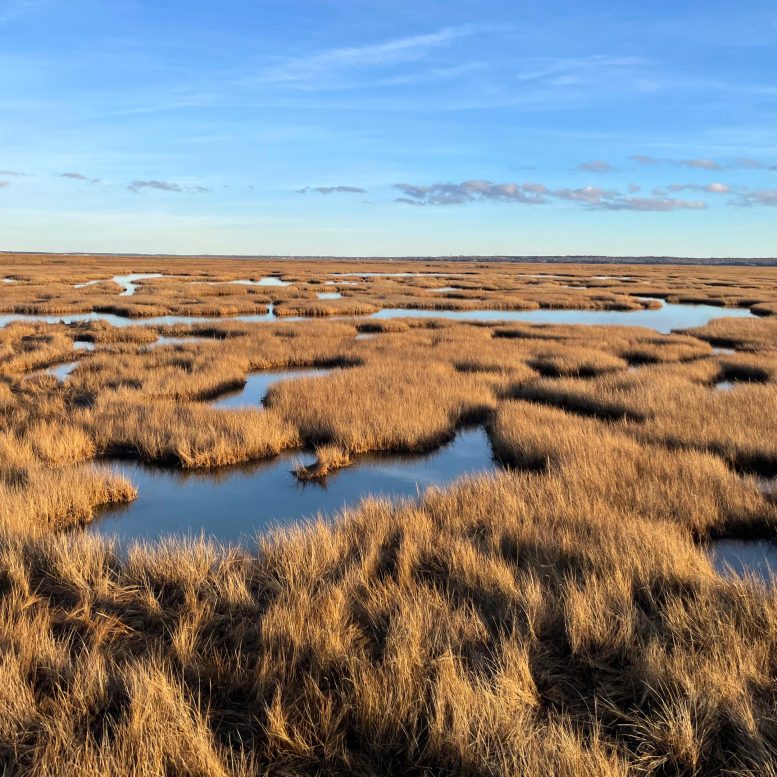
A salt marsh in Barnstable, Massachusetts, shows signs of erosion and drowning as the sea level rises (December 2, 2022). Credit: Erin Peck
Building up wetlands that are drowning under rising oceans remains a challenge, but scientists are now one step closer to identifying solutions.
Amid climate change, large dam removal projects have gained attention as a solution to the loss of coastal wetlands that reduce flooding, filter water, and provide wildlife habitat. But in a just-released paper in Science, researchers concluded this strategy won’t work in most U.S. rivers.
Limited Sediment Supply Hinders Wetland Restoration
The reason, they said, is not enough sediment. Of the nearly 5,000 rivers analyzed, almost three out of every four could not deliver enough sediment to match the sea-level rise in their connected coastal areas. Nearly half fell short of the amount of sediment needed by at least 10-fold.
This is the first national study to examine how much watershed sediment could be deposited by rivers into coastal areas. Until now, research has focused on a few very large rivers like the Mississippi, and steep rivers like the Elwha in Washington, that are not representative of most others in the contiguous United States.
According to the researchers, most U.S. watersheds are small and are not the leading source of sediment buildup in wetlands. It’s on these small rivers that most dams exist.
Expert Insights on Dam Removal and Sediment Supply
Research Scientist Scott Ensign, Ph.D., of Stroud Water Research Center, a nonprofit that studies freshwater streams and rivers around the world, led the study. He said, “The Elwha is the poster child for a dam removal project restoring coastal sediment, and for good reason: it liberated an enormous amount of sediment and sand.
“However, rivers along the East and Gulf coasts are less steep than on the West Coast, and they have less sediment that could potentially reach wetlands — wetlands that are larger, requiring more sediment to keep them above rising seas. Basically, the numbers don’t add up.”
Christopher Craft, Ph.D., a professor at the University of Indiana who focuses on wetland restoration and climate change, said, “The expansive and comprehensive spatial analysis conducted by the authors strongly suggests that sediment supply of most coastal watersheds is inadequate to sustain tidal wetlands as sea level rises. In other words, sediment will not save them.”
Methodology and Findings
Ensign and his co-authors, Joanne Halls from the University of North Carolina Wilmington and Erin Peck from the University of Massachusetts, used publicly available data from the U.S. Geological Survey and National Oceanic and Atmospheric Administration to model the supply of watershed sediment to coastal wetlands using ArcGIS Pro technology from Esri. They then compared their predictions to tidal wetlands around the U.S. with previously reported rates of change.
“By and large, the sediment that saves most wetlands from drowning doesn’t come from the river upstream. In many places on the East Coast, removing dams won’t help. We have to look elsewhere,” Ensign explained.
Implications for Wetland Preservation
James Pizzuto, Ph.D., a professor of geological sciences specializing in river science at the University of Delaware, said that the researchers cleverly addressed a complex problem. “These results, and the local variations documented by mapping the entire coastal U.S., provide essential guidance to managers and scientists, documenting where future efforts should focus on other processes beyond watershed sediment,” he said.
Such efforts might include finding ways to keep more mineral sediments, plant material, and organic carbon in wetland soils, explained Donald F. Boesch, professor emeritus of the University of Maryland Center for Environmental Science. He said, “This is true both where they are sediment-starved and where sediments are being diverted to build and maintain wetlands experiencing high rates of relative sea-level rise, such as in the Mississippi Delta.”
Future Research and Conservation Strategies
Future studies are needed to measure how much sediment is trapped behind specific dams and to accurately predict its effect on tidal wetlands downstream.
Ensign said, “Across the board, the most important action for saving tidal wetlands is to allow them to migrate upslope. In some areas, this will require restoring natural hydrology and preserving low-lying land. Direct application of sediment and other engineering approaches can also be useful at very local scales.”
Reference: “Watershed sediment cannot offset sea level rise in most US tidal wetlands” by Scott H. Ensign, Joanne N. Halls and Erin K. Peck, 7 December 2023, Science.
DOI: 10.1126/science.adj0513
The National Science Foundation funded the research.









“…, almost three out of every four could not deliver enough sediment to match the sea-level rise in their connected coastal areas.”
Implicit in this statement is the unstated assumption that it is unnatural for oceans to rise or for coastal wetlands to subside. The statement is filtered through the anthropogenic view that the prevention of the loss of human infrastructure should take precedence over everything else and we should try to prevent change, whether we are responsible for it or not. One should always examine their basic assumptions!